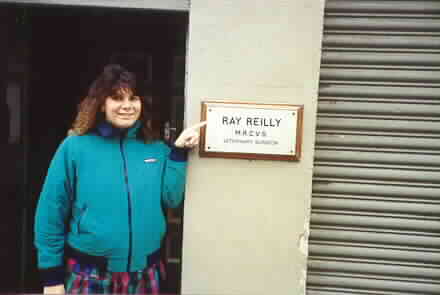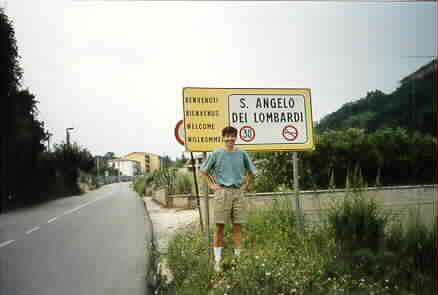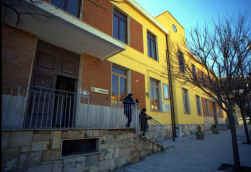| Assimilation: Migration |
||
| Home Immigration Life in Brooklyn Assimilation Research |
Why did my family leave
Brooklyn?
Voyages back
My wife next to a veterinarian with my Fathers name on Cavan's High Street. In the Fall of 1992 with our first child on the way, my wife and I decided to visit Ireland. I was not actively pursuing genealogy at the time although I had worked on my family tree when I was younger and knew that my great-grandfather had come from Cavan Town in Cavan County Ireland. Although our itinerary focused on the western cost of Ireland, I convinced my wife that we had to pass through Cavan located in the north-central part of Ireland just below Ulster. To get to Cavan, we went from Donegal through Northern Ireland passing through check points manned by British soldiers who looked barely 18. There is a series of lakes along the border with Cavan which is far less populated than the Ulster countryside we had just passed through. The countryside along our drive was heavily wooded with occasional lakes and very few towns. There is little sign of the high population that once filled this region unlike the coastal region which is peppered with empty one-room cottages. This area is also without the castles that seemed to be everywhere else we went. If I had done some research I would have found out that we passed right by my great-grandfather's birthplace just before we entered Cavan Town. Cavan is a market town centrally located and dominated by a high street leading up a tall hill. This has been an important market town for hundreds of years in this region. We had little time so I decided to get my genealogy work done. As a young boy, my great-grandfather had never provided very much of a response to my genealogy questions. When I asked if we there ever was an O' before Reilly in our name his response was yes...but it had dropped in the ocean on the way over. I had never pursued it further and I had little additional information as we searched for the parish hall to at least make a contact for further research. Unfortunately, it was a weekend and the center was closed. I still was happy to have visited and 5 years afterwards my father and grandfather made the trip to Ireland but they never made it back to our family's hometown.
Myself in the valley beside S.Angelo dei Lombardi, Aug.1994. The town is up the hill on the right. While living in France during the early 1990s, we managed to find a babysitter for our children and planned a long weekend in Southern Italy. I convinced my wife that a day-long side trip to my grandfather's hometown was a must since we were in the neighborhood. The drive out from Naples follows a valley eastward past Vesuvius which dominates the landscape towards the south. About 2 hours out is Avellino which is the administrative center of the region. Leaving the highway, we headed up into the foothills which stretch out towards the southeast from Vesuvius. This region had been hit hard by an earthquake a ten years earlier in 1980 but we didn't see any signs of damage. The country is open with many farms in various states of activity and medium sized trees filling the difficult to farm areas. Our map's detail was not sufficient and we were quickly lost but we flagged down a motorist who guided us the remaining 10 miles to the ridge line above S. Angelo. Looking westward from the ridgeline, the road descends down between two ridges with St. Angelo on the left and Torella on the right. Not knowing about the link with Torella at the time, we headed down through the valley, took the picture above, and reclimbed the hill towards the town which sits along a ridge. The main street follows the ridgeline and has a large open plaza near the church that was described earlier. We headed for the Commune where we hoped to find someone working during that weekday afternoon.
S. Angelo Commune The commune was a ugly tan postwar building which housed several government functions around an open courtyard. It was very quiet as we roamed the halls looking for somebody in the records department. While I had taught myself enough Italian to communicate with city officials, I had still not learned my lesson of preparation after the Cavan trip. We found the room with the records but it was locked. The people working in the building told us that the person responsible was not working today but would be back the next day which was impossible for us. I pleaded them to look and they let me in and we found the book with the records for the time period in question. The records were bound and ordered by date with records of many types mixed together. After a brief look, the person got cold feet and reconsidered her offer. We gave up and had an ice cream in a bar overlooking the valley and headed back through the countryside towards Naples. Since that time I have read many good books on how to do this properly. While I didn't get records from the trip I did come away with a picture in my mind of the small farming communities outside Naples that filled the boats to America at the turn of the century. My grandfather who immigrated at age 3 has never returned to Italy. He loved hearing about the trip and keeps the photo above prominently displayed. Voyages back via the Internet My grandparents have no connection with relatives in Europe and little interest in looking backwards as they put it. My family connection to cities such as San Constantino Albanese only surfaced after piecing together many clues. The Arberesh forums and people I have met through this service have been particulary helpful in describing the past and current nature of these communities. I am fortunate that my Italian surnames are uncommon. My Polish and Irish surnames are both common enough to make the Internet a less efficient place to search. I appreciate any leads that can be left on the guest page. Distribution of Surnames The following is a very non-scientific study of the number of surnames in the U.S. and home country. The U.S. source was Yahoo's peoplefinder and a European search index. Blumetti
Klosek
Pomarico
Reilly
Scutari
Sogga
|
![]()


